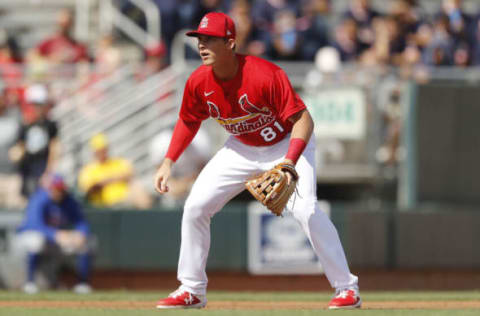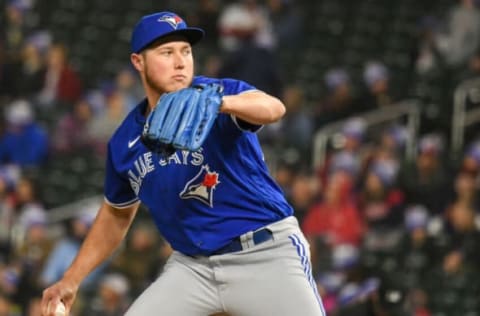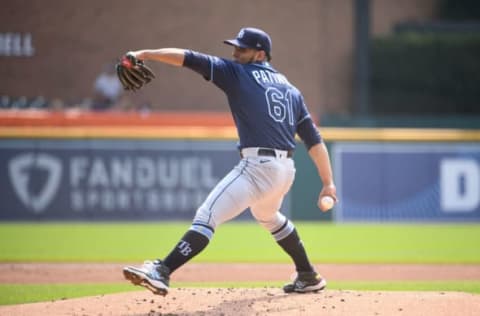Detroit Tigers: 3 potential Casey Mize trades

Casey Mize was the first overall pick in 2018, and this year he joined Justin Verlander as the only rookie pitchers in Detroit Tigers history to make 30 starts, throw at least 150 innings, and finish with an ERA under 3.80. So, what could the Tigers get for Casey Mize if they traded him now?
Casey Mize looks like a legitimate building block for the Detroit Tigers as they climb back into contention, but as a recent Tweet from Lynn Henning suggested, draft picks and free agency can only take this team so far:
But Tigers need at least two big bats, on top of the upcoming arrivals of Riley Greene and Torkelson, etc. Catcher complicates matters, entirely, with Jake Rogers gone in 2022. Will not be surprised to see them deal one of their young blue-chip pitchers, with Casey Mize a guess.
— Lynn G. Henning (@Lynn_Henning) September 29, 2021
From 2017-2020 the Detroit Tigers played .365 baseball, which equates to about 59 wins per 162 games. This year they played at a .463 clip and won 77 games, a 30-game improvement over their 2019 record.
But don’t be fooled by how long it took the Tigers to play respectable baseball again. That was the easy part. The hard part is finding the next 15 wins to make Detroit a real playoff contender.
And sometimes getting over the top means trading a chance to be good for a smaller chance to be great.
Why Trade Casey Mize?
Trades in Major League Baseball tend to land in three categories:
- Under-the-radar deals for fringe big-leaguers (Jefry Marte for Kody Eaves)
- Straightforward prospect-for-veteran deals (the Justin Verlander trade)
- Swapping young MLB players for one another (the Granderson/Scherzer deal)
We can cross off that first bullet point immediately, because Casey Mize is more than a fringe big leaguer. And cross off the second point, too, as the Tigers aren’t about to part with Mize and prospects for veterans near free agency (Aaron Judge) or on a long-term deal (Bryce Harper).
That leaves the third category of trade, which is kind of a fun place to play.
Matt Manning, Casey Mize, and Tarik Skubal were all rookies in 2021, and together they started nearly 48% of Detroit’s games in 2021. Casey Mize was easily the most consistent of the three young hurlers — at one point he went 14 consecutive starts without allowing more than three earned runs. He allowed four or more earned runs in just 4 of his 30 starts.
That level of consistency can be awfully valuable. But Mize also never showed signs of dominance the way Skubal did, and he wasn’t a big strikeout pitcher this year. Both his FIP (4.71) and xERA (4.89) finished well above his actual ERA (3.71).
We aren’t suggesting Casey Mize is bad by any means, and he has plenty of time to get better. But, if we go back to that famous Curtis Granderson deal, right now Mize looks more like Ian Kennedy than Max Scherzer — a solid mid-rotation arm with a high floor and a moderate ceiling.
The Tigers farm system is awfully thin on pitching, so trading away any arm seems inadvisable. But no one knows Mize better than Chris Fetter and the Tigers, and they just managed to wrangle similar production from the tandem of Tyler Alexander and Wily Peralta.
So perhaps they’re confident in their ability to find pitching elsewhere, and want to use Casey Mize as a means to address other needs on the club. And if that’s the case, just what kind of trades could they pursue?
Casey Mize Trade Option Number 1 – The St. Louis Cardinals

The St. Louis Cardinals were a thoroughly average team for most of 2021 until they put together a historic 17-game winning streak in September and earned a Wild Card berth. That’s an impressive feat, particularly when their starting rotation finished 21st in fWAR (7.9), right behind the Detroit Tigers (8.1). Adam Wainwright was terrific in his age-39 season, but budding young ace Jack Flaherty was injured and ineffective for most of the year, and many of their starts went to converted relievers like John Gant and Carlos Martínez, or aging veterans like Jon Lester and J.A. Happ.
Meanwhile, the Cardinals offense finished with the 3rd best WAR in the National League, behind only the Dodgers and Giants. And most of that talent isn’t going anywhere. The outfield trio of Harrison Bader, Dylan Carlson, and Tyler O’Neill all remain under team control for at least two more seasons, while all-star infielders Nolan Arenado, Paul DeJong, and Paul Goldschmidt are signed for multiple years. And then there’s 26-year-old second baseman Tommy Edman, who isn’t a star by any means, but just put together a 2+ WAR season, finished second in the National League with 30 stolen bases, and isn’t a free agent until 2026.
Like Casey Mize, Nolan Gorman was drafted in the first round in 2018, and he quickly established himself as a top-100 prospect after bashing 17 home runs in his first 63 pro games. Gorman has a strong arm, and had a chance to be an average defender at third base, but he began playing mostly second base when the Cardinals acquired Arenado. To Gorman’s credit, he has been adequate at his new position, but given his size and age (he’s just four months older than Riley Greene) it seems unlikely he can stick at the keystone for long.
A universal DH might solve this problem, and the Cardinals probably wouldn’t hesitate to move Edman to make room for Gorman. But St. Louis has plenty of offense, and Tommy Edman probably doesn’t bring back Casey Mize. In Gorman, the Tigers get another potential cornerstone power bat who could develop into something of a left-handed Austin Riley. Isaac Paredes and Johan Oviedo are both young players with promising upside but no MLB success yet, and here they get a change of scenery while providing their new teams with a little bit of positional insurance.
Casey Mize Trade Option Number 2 – The Toronto Blue Jays

The Toronto Blue Jays had one of the most fearsome offenses in all of baseball this year, but their pitching let them down far too often. Potential Cy Young winner Robbie Ray is a free agent, and so is Steven Matz, who posted a solid 3.82 ERA and finished third on the team with 150.2 IP. Jose Berrios is only signed through 2022, and Hyun Jin Ryu is a free agent after 2023, so the Blue Jays could definitely use another young starter to go alongside Alek Manoah.
Toronto’s infield was spectacular this year, but Marcus Semien is likely to turn his MVP-caliber production into a massive free agent deal elsewhere. Jeimer Candelario can’t make up for that power, but, his on-base percentage was about 20 points higher than Semien’s this year, and he would give Toronto a much-needed lefty bat for the next two seasons. Santiago Espinal was quietly solid for Toronto this year, and he played plenty of second base in the minors, so he can easily slide over from third. Michael Fulmer is in his final season before free agency, but he’d be a huge addition to Toronto’s bullpen, and the Blue Jays could pretty easily sign him to an extension if things go well.
Toronto has an abundance of young infielders and catchers, both at the MLB level and in the minors, so they can afford to make a trade like this, but it probably qualifies as a high-risk, high-reward move for the Tigers. Jordan Groshans has battled injuries ever since he was drafted 12th overall in 2018, but he has remained a top-100 prospect because he shows plenty of potential whenever he does play. He turns 22 next month and has just 146 career pro games under his belt, but he owns a .300/.372/.453 career batting line, and this year in Double-A he hit .291 with a 10.8% walk rate, seven home runs, and 23 doubles in just 75 games. He has played a lot of shortstop, but he probably fits best at third base.
Few pitchers in baseball have the pure arm talent of Nate Pearson. He was generally regarded as a top-20 prospect in all of baseball over the previous two seasons, his fastball topped out at 101.8 MPH this year, and he famously hit 104 MPH in the Arizona Fall League. But, like Groshans, Pearson has dealt with a number of injuries over the past few seasons, and he has walked 25 batters in just 33 MLB innings. There’s still some front-line starter potential here, but also a lot of reliever risk. And Reese McGuire helps solve Detroit’s catching problem, at least in the short term. He doesn’t offer much power, but he grades out well on defense, and he’s a left-handed hitter with a career 102 wRC+ against right-handed pitching.
Casey Mize Trade Option Number 3 – The Tampa Bay Rays

The Tampa Bay Rays just won the AL East and posted the best regular season in franchise history. But, when they fell to Boston in the Division Series, critics were quick to blame their it-takes-a-village approach to pitching — Tampa used 15 different starters during the regular season, and just one of their pitchers topped 125 innings this year. That argument seems specious (the White Sox and Giants had traditional pitching rotations and suffered the same fate as the Rays), but Tampa does need to trim their pitching staff simply to avoid a massive roster crunch. As of this writing, the Rays have 52 players on their 40-man roster.
Free agency will clear up some of the logjam, but Tampa is so good at acquiring and developing talent that roster constraints have become an annual issue. This trade proposal is designed to help alleviate that by having Tampa send away three players currently on their 40-man roster (and a fourth who would likely be added) in exchange for two 40-man players and two more who don’t need to be added until the end of 2023. And, as a high-probability innings-eating starter, Casey Mize is almost a two-for-one swap on his own.
In return, the Detroit Tigers get the electric Luis Patiño, who is younger than Mize, has better pitch metrics, and shows solid control, but throws tons of fastballs and hasn’t found a viable third pitch yet. Austin Meadows is a 26-year-old lefty outfielder with power, patience, and strong traditional stats, but he’s getting more expensive as he enters his arbitration years, and he doesn’t offer much value away from the plate. Taylor Walls has the opposite issue, as a solid defender without a ton of offensive potential, and Ford Proctor is a left-handed hitter with decent power, good patience, and interesting versatility. He was a middle infielder in college and for most of pro ball, but this year he played more than half of his games as a catcher.
Free agent catcher options for the Detroit Tigers. dark. Next